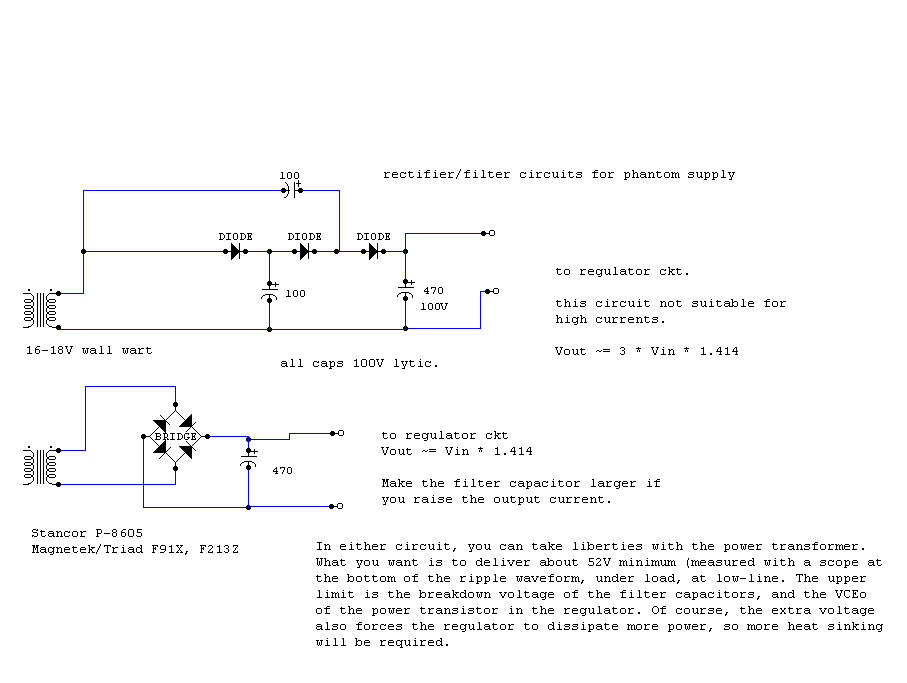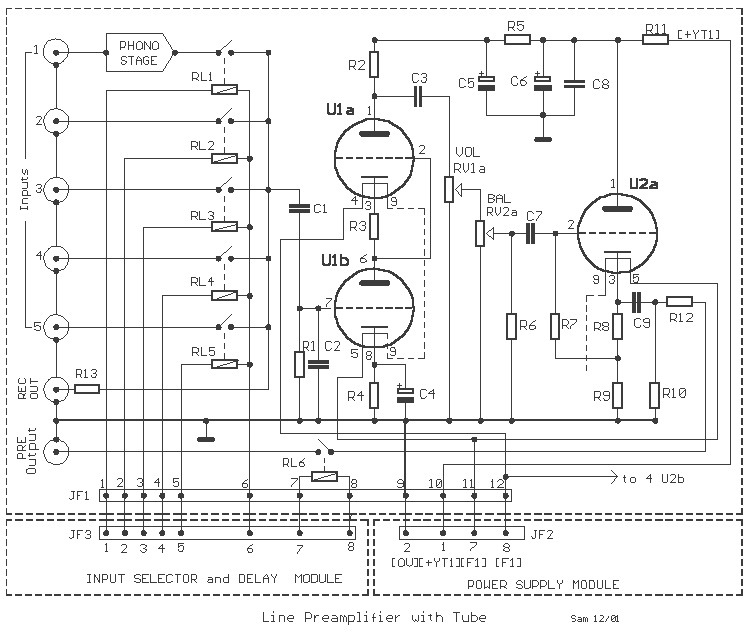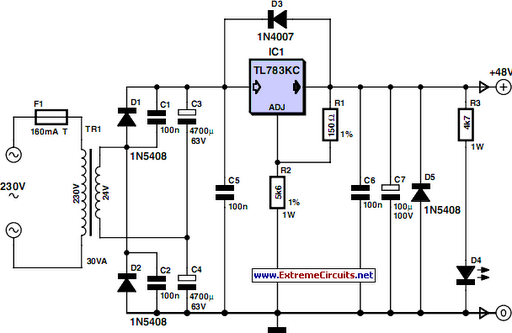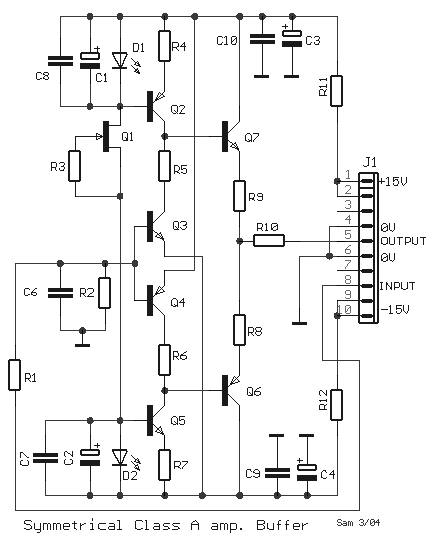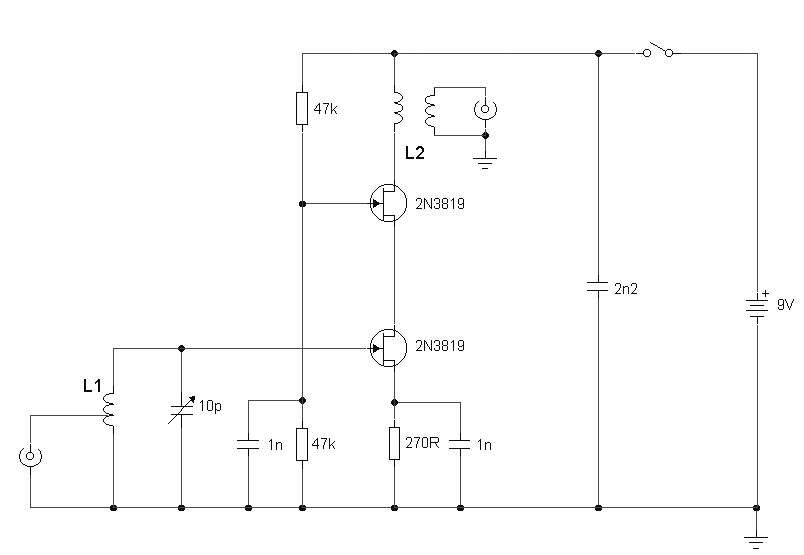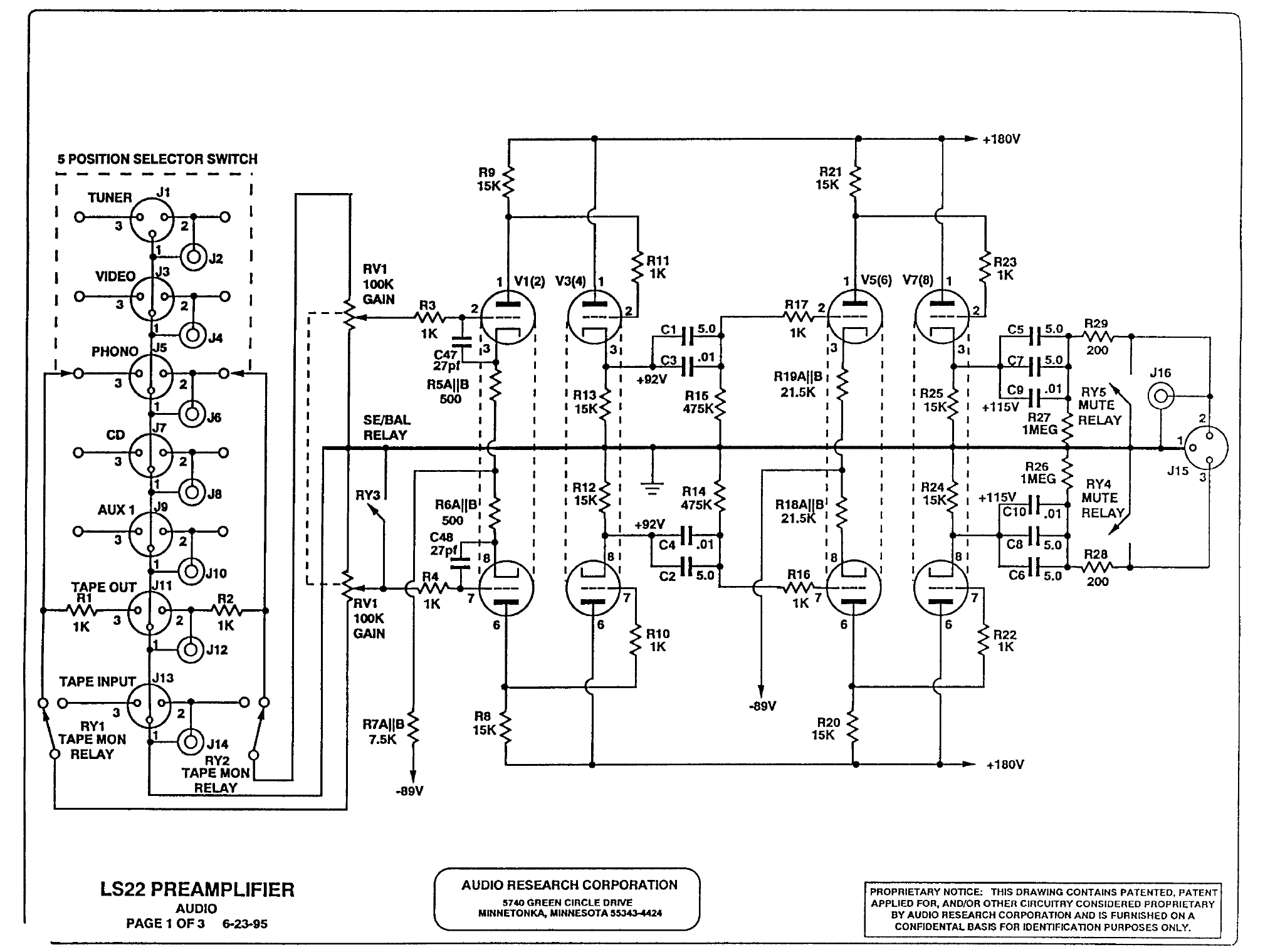
Ultra-Simple Microphone Preamplifier
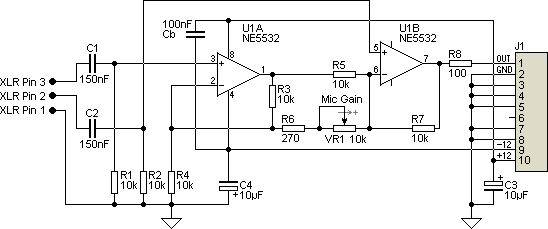
This project originated from a design requirement for a client, specifically for a microphone preamplifier intended for basic public address (PA) systems. The simplicity of this circuit makes it suitable for various applications where a mic preamp is needed, particularly for interfacing balanced microphones with PC sound cards or other audio equipment. Unlike most projects, this board is double-sided, which is typically avoided due to the risk of damage during rework by inexperienced users. However, the simplicity of this design mitigates that risk. The board features a PCB-mounted XLR connector and potentiometer, making it a complete mic preamp solution. The terminals labeled SW1, located between the two electrolytic supply capacitors, are specific to client requirements for a push-button switch activating an audio switch via a PIC microcontroller and are not relevant for general applications. The DC, ground, and output terminals can be hardwired to the board or connected using PCB pins or a 10-way IDC (Insulation Displacement Connector) with ribbon cable. Power supply requirements range from +/-9V to +/-18V utilizing an NE5532 operational amplifier. The mic input is electronically balanced, providing low noise performance when using the recommended op-amp. The gain of the preamp varies from approximately 12dB to 37dB, with potential for adjustment by altering the value of resistor R6, although such adjustments are generally unnecessary. The gain control, while not perfectly linear due to the unavailability of anti-logarithmic potentiometers, is typical for mic preamps employing similar variable gain control systems. The circuit design is conventional, and using 1% metal film resistors throughout ensures at least 40dB of common-mode rejection under worst-case conditions. Input capacitors provide a low-frequency roll-off at -3dB around 104Hz, with the option to increase capacitance to 4.7uF or 10uF bipolar electrolytics for improved low-frequency response, extending down to below 10Hz if necessary. The PCB dimensions are 77 x 24mm, with mounting centers for the potentiometer and XLR connector spaced at 57mm. Alternatively, a traditional chassis-mounted female XLR can be utilized, connected to the board with heavy tinned copper wire, and the PCB pads for the connector are arranged correctly for a female chassis mount socket with the "Push" tab positioned at the top.
This microphone preamplifier circuit is designed to be user-friendly and adaptable for various audio applications. The double-sided PCB layout, while typically more complex, is made accessible through the straightforward design, which minimizes the likelihood of user error during assembly or modification. The choice of the NE5532 op-amp is significant due to its low noise characteristics and high performance, making it suitable for professional audio applications.
The gain configuration allows for flexibility based on user needs, with the option to adjust resistor R6 for those requiring a different gain structure. However, the preamp is optimized for a gain range that should suffice for most standard applications. The design's robustness is further enhanced by the use of high-quality components, including metal film resistors that contribute to the overall performance and reliability of the circuit.
The input capacitors are vital for defining the low-frequency response of the preamp. Users who require extended low-frequency performance can easily modify the capacitor values, demonstrating the design's adaptability. The physical dimensions of the PCB facilitate easy integration into various enclosures, while the mounting options for the XLR connector ensure compatibility with different setups.
Overall, this microphone preamp circuit serves as an effective solution for users needing a reliable and straightforward interface for balanced microphones, making it a valuable addition to any audio project.This little project came about as a result of a design job for a client. One of the items needed was a mic preamp, and the project didn`t warrant a design such as the P66 preamp, since it is intended for basic PA only. Since mic preamps are needed by people for all manner of projects, this little board may be just what`s needed for interfacing a b
alanced microphone with PC sound cards or other gear. Unlike most of my boards, this one is double-sided. I normally avoid double-sided PCBs for projects because rework by those inexperienced in working with them will almost certainly damage the board beyond repair. I consider this not to be an issue with this preamp, because it is so simple. It is extremely difficult to make a mistake because of the simplicity. As you can see, the board uses a PCB mounted XLR connector and pot, so is a complete mic preamp, ready to go.
Feel free to ignore the terminals marked SW1 (centred between the two electrolytic supply caps), as they are specific to my client`s needs and are not useful for most applications. The original use was to use them for a push-button switch that activated an audio switch via a PIC micro-controller.
They are not shown on the schematic. The DC, GND and output terminals may be hard wired to the board, you may use PCB pins or a 10-way IDC (Insulation Displacement Connector) and ribbon cable. Power can be anything between +/-9V and +/-18V with an NE5532 opamp. The mic input is electronically balanced, and noise is quite low if you use the suggested opamp. Gain range is from about 12dB to 37dB as shown. It can be increased by reducing the value of R6, but this should not be necessary. Because anti-log pots are not available, the gain control is not especially linear, but unfortunately in this respect there is almost no alternative and the same problem occurs with all mic preamps using a similar variable gain control system.
The circuit is quite conventional, and if 1% metal film resistors are used throughout it will have at least 40dB of common mode rejection with worst-case values. The input capacitors give a low frequency rolloff of -3dB at about 104Hz. If better low frequency response is required, these caps may be increased to 4. 7uF or 10uF bipolar electrolytics. These will give response to well below 10Hz if you think you`ll ever need to go that low. The project PCB measures 77 x 24mm, and the mounting centers for the pot and XLR connector are spaced at 57mm.
If preferred, a traditional chassis mounted female XLR can be used, and wired to the board with heavy tinned copper wire. The PCB pads for the connector are in the correct order for a female chassis mount socket mounted with the "Push" tab at the top.
🔗 External reference
This microphone preamplifier circuit is designed to be user-friendly and adaptable for various audio applications. The double-sided PCB layout, while typically more complex, is made accessible through the straightforward design, which minimizes the likelihood of user error during assembly or modification. The choice of the NE5532 op-amp is significant due to its low noise characteristics and high performance, making it suitable for professional audio applications.
The gain configuration allows for flexibility based on user needs, with the option to adjust resistor R6 for those requiring a different gain structure. However, the preamp is optimized for a gain range that should suffice for most standard applications. The design's robustness is further enhanced by the use of high-quality components, including metal film resistors that contribute to the overall performance and reliability of the circuit.
The input capacitors are vital for defining the low-frequency response of the preamp. Users who require extended low-frequency performance can easily modify the capacitor values, demonstrating the design's adaptability. The physical dimensions of the PCB facilitate easy integration into various enclosures, while the mounting options for the XLR connector ensure compatibility with different setups.
Overall, this microphone preamp circuit serves as an effective solution for users needing a reliable and straightforward interface for balanced microphones, making it a valuable addition to any audio project.This little project came about as a result of a design job for a client. One of the items needed was a mic preamp, and the project didn`t warrant a design such as the P66 preamp, since it is intended for basic PA only. Since mic preamps are needed by people for all manner of projects, this little board may be just what`s needed for interfacing a b
alanced microphone with PC sound cards or other gear. Unlike most of my boards, this one is double-sided. I normally avoid double-sided PCBs for projects because rework by those inexperienced in working with them will almost certainly damage the board beyond repair. I consider this not to be an issue with this preamp, because it is so simple. It is extremely difficult to make a mistake because of the simplicity. As you can see, the board uses a PCB mounted XLR connector and pot, so is a complete mic preamp, ready to go.
Feel free to ignore the terminals marked SW1 (centred between the two electrolytic supply caps), as they are specific to my client`s needs and are not useful for most applications. The original use was to use them for a push-button switch that activated an audio switch via a PIC micro-controller.
They are not shown on the schematic. The DC, GND and output terminals may be hard wired to the board, you may use PCB pins or a 10-way IDC (Insulation Displacement Connector) and ribbon cable. Power can be anything between +/-9V and +/-18V with an NE5532 opamp. The mic input is electronically balanced, and noise is quite low if you use the suggested opamp. Gain range is from about 12dB to 37dB as shown. It can be increased by reducing the value of R6, but this should not be necessary. Because anti-log pots are not available, the gain control is not especially linear, but unfortunately in this respect there is almost no alternative and the same problem occurs with all mic preamps using a similar variable gain control system.
The circuit is quite conventional, and if 1% metal film resistors are used throughout it will have at least 40dB of common mode rejection with worst-case values. The input capacitors give a low frequency rolloff of -3dB at about 104Hz. If better low frequency response is required, these caps may be increased to 4. 7uF or 10uF bipolar electrolytics. These will give response to well below 10Hz if you think you`ll ever need to go that low. The project PCB measures 77 x 24mm, and the mounting centers for the pot and XLR connector are spaced at 57mm.
If preferred, a traditional chassis mounted female XLR can be used, and wired to the board with heavy tinned copper wire. The PCB pads for the connector are in the correct order for a female chassis mount socket mounted with the "Push" tab at the top.
🔗 External reference
